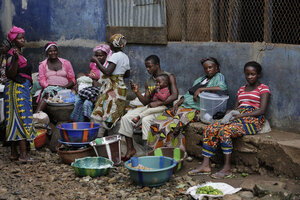In post-Ebola Sierra Leone, aid is needed, but not all is helpful
The three West African countries at the heart of the Ebola epidemic have recorded their first week with no new cases. But the world's good intentions can sometimes have an opposite effect.

Women sell food at a market in Kenema, Sierra Leone, as life slowly returns to normal across the country.
Sunday Alamba/AP
Kpondu, Sierra Leone
Ebola came to Kpondu in mid-2014 like a rainstorm in Sierra Leone’s wet season – sudden and furious. It began with the death of a local traditional healer who had fallen ill after a trip across the nearby border into Guinea. Within weeks, 21 more were dead, nearly 10 percent of the village’s population.
By the time I arrived in Kpondu, nestled in Sierra Leone’s far east, in July 2015, the storm had passed. It had been more than 200 days since the last recorded case of Ebola, and life seemed to be quietly easing back towards normal. On the rutted road into Kpondu, I watched farmers once again hacking their way through the lush cocoa and coffee fields they had been forced to abandon, and women balancing heavy cargos of red palm oil on their heads, bound for markets just across the border in Guinea and Liberia.
Ebola checkpoints still dotted the main roads, but their guardians waved passing cars through listlessly, no longer bothering to check every passenger for the scalding fever that was the telltale sign of the disease.
It was a tableau of a recovery at once tremendously mundane and hopeful. There was little of interest to see, and that was exactly the point.
But the longer I spent in and around Kpondu, the more it became clear that the disease’s retreat was beginning to spawn an unexpected new threat.
“We have a big problem now with aid,” Nyuma Tommy, Kpondu’s chief, told me. International NGOs, he said, were now visiting the village regularly, “bringing assistance to orphans and survivors, and nothing to all the rest.” Every month, he said, villagers watched as SUVs rumbled in to deposit food parcels at the homes of these chosen few. Were those who had cared for the dying or lost their closest friends not just as deserving? Had everyone here not suffered enough to merit assistance?
It was a complaint I heard again and again across Sierra Leone: international aid organizations, attempting to ease the burden of those who had suffered most from Ebola, were actually making recovery more difficult, breeding suspicion, distrust, and jealousy in tight-knit villages where communal support offered the best chance for physical and psychological recovery from the disease’s traumas.
“These are serious conflicts,” a community activist named Mariatu Koroma told me. “Everyone here in this region was quarantined. Everyone lost their farms. Why are only some getting benefits now?”
Sierra Leone is the kind of country that appears on the world stage in bright, blinding flashes – a brutal civil war, a mysterious killer disease — and all but disappears in between. It is child soldiers and blood diamonds, morgues overflowing with unrefrigerated bodies and people hiding from the strange specter of a disease no one can cure. Like Haiti or Somalia or the Congo, Sierra Leone often seems to be what writer Adam Hochschild has called a “mirror at midnight” – a reflection of humanity at its darkest, most desperate self.
Of course, seeing a country that way can inspire deep compassion, and Sierra Leone often feels like a graveyard of the entire world’s good intentions. Its villages and towns are scattered with slouching signboards announcing a parade of foreign-sponsored aid projects – boreholes and school feeding programs, micro-lenders and community clinics. Some of these, of course, have improved life here, but for every project that’s been effective, the Sierra Leoneans I talked to could point to twice as many that flashed and fizzled.
There was the cassava processing machine that only one villager was trained to use, and so, after his death, quickly became a rusted antique. Or the gleaming new market built a mile outside one town, where it was so inconvenient to visit that no one bothered to use it. Everywhere I went, it seemed, there was so much money, so much earnest desire to help, and so few results.
For me, all of this was a great reminder of how dangerous an emotion compassion can be, how quickly it can slant towards pity, then condescension – how quickly we can forget to ask those we want to help what they really need. That is a danger not only for aid workers and donors, but for journalists as well. It is so easy to write of the poor, sick, and suffering in a way that makes them seem pitiable and worthy of our empathy and open wallets. It’s so much harder to bring the rest of their lives into the same, sharp focus, to remind readers that our subjects, like us, have complex, contradictory, and sprawling lives that resist easy categorization or easy solutions. That they are not simply empty vessels for us to pour our guilt and good intentions into.
This week, West Africa passed a major milestone. For the first time since March 2014, there was not a single new case of Ebola recorded in Sierra Leone, Liberia, or Guinea. When I heard this news, I found myself reminded suddenly of a rusted silver Toyota Corolla I passed on the side of the narrow highway east of Freetown, which was improbably sprouting a tree from its crumpled hood. How, I had wondered then, could a tree claw through steel and rust and wire that way? It seemed to me audacious, almost unbelievable that it was attempting to survive in those circumstances.
But there it was anyway, carrying on, immune to my expectations.

